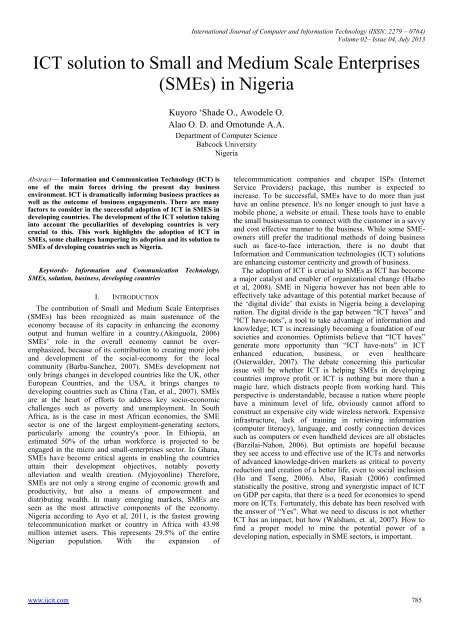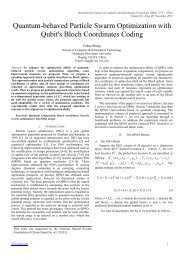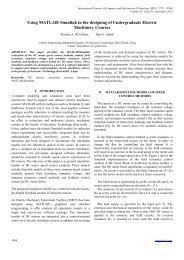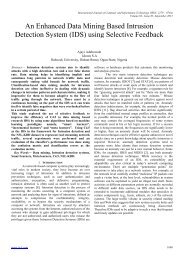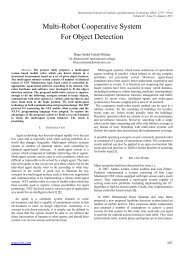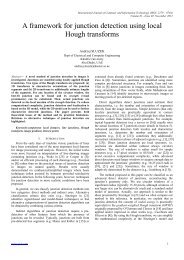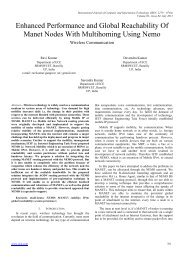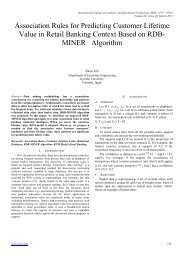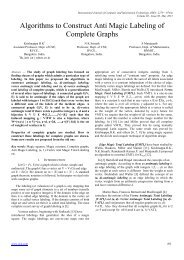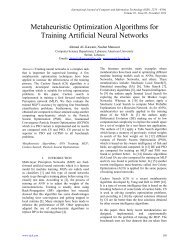ICT solution to Small and Medium Scale Enterprises (SMEs) in Nigeria
ICT solution to Small and Medium Scale Enterprises (SMEs) in Nigeria
ICT solution to Small and Medium Scale Enterprises (SMEs) in Nigeria
You also want an ePaper? Increase the reach of your titles
YUMPU automatically turns print PDFs into web optimized ePapers that Google loves.
International Journal of Computer <strong>and</strong> Information Technology (ISSN: 2279 – 0764)<br />
Volume 02– Issue 04, July 2013<br />
<strong>ICT</strong> <strong>solution</strong> <strong>to</strong> <strong>Small</strong> <strong>and</strong> <strong>Medium</strong> <strong>Scale</strong> <strong>Enterprises</strong><br />
(<strong>SMEs</strong>) <strong>in</strong> <strong>Nigeria</strong><br />
Kuyoro ‘Shade O., Awodele O.<br />
Alao O. D. <strong>and</strong> Omotunde A.A.<br />
Department of Computer Science<br />
Babcock University<br />
<strong>Nigeria</strong><br />
Abstract— Information <strong>and</strong> Communication Technology (<strong>ICT</strong>) is<br />
one of the ma<strong>in</strong> forces driv<strong>in</strong>g the present day bus<strong>in</strong>ess<br />
environment. <strong>ICT</strong> is dramatically <strong>in</strong>form<strong>in</strong>g bus<strong>in</strong>ess practices as<br />
well as the outcome of bus<strong>in</strong>ess engagements. There are many<br />
fac<strong>to</strong>rs <strong>to</strong> consider <strong>in</strong> the successful adoption of <strong>ICT</strong> <strong>in</strong> SMES <strong>in</strong><br />
develop<strong>in</strong>g countries. The development of the <strong>ICT</strong> <strong>solution</strong> tak<strong>in</strong>g<br />
<strong>in</strong><strong>to</strong> account the peculiarities of develop<strong>in</strong>g countries is very<br />
crucial <strong>to</strong> this. This work highlights the adoption of <strong>ICT</strong> <strong>in</strong><br />
<strong>SMEs</strong>, some challenges hamper<strong>in</strong>g its adoption <strong>and</strong> its <strong>solution</strong> <strong>to</strong><br />
<strong>SMEs</strong> of develop<strong>in</strong>g countries such as <strong>Nigeria</strong>.<br />
Keywords- Information <strong>and</strong> Communication Technology,<br />
<strong>SMEs</strong>, <strong>solution</strong>, bus<strong>in</strong>ess, develop<strong>in</strong>g countries<br />
I. INTRODUCTION<br />
The contribution of <strong>Small</strong> <strong>and</strong> <strong>Medium</strong> <strong>Scale</strong> <strong>Enterprises</strong><br />
(<strong>SMEs</strong>) has been recognized as ma<strong>in</strong> sustenance of the<br />
economy because of its capacity <strong>in</strong> enhanc<strong>in</strong>g the economy<br />
output <strong>and</strong> human welfare <strong>in</strong> a country.(Ak<strong>in</strong>guola, 2006)<br />
<strong>SMEs</strong>’ role <strong>in</strong> the overall economy cannot be overemphasized,<br />
because of its contribution <strong>to</strong> creat<strong>in</strong>g more jobs<br />
<strong>and</strong> development of the social-economy for the local<br />
community (Barba-Sanchez, 2007). <strong>SMEs</strong> development not<br />
only br<strong>in</strong>gs changes <strong>in</strong> developed countries like the UK, other<br />
European Countries, <strong>and</strong> the USA, it br<strong>in</strong>gs changes <strong>to</strong><br />
develop<strong>in</strong>g countries such as Ch<strong>in</strong>a (Tan, et al., 2007). <strong>SMEs</strong><br />
are at the heart of efforts <strong>to</strong> address key socio-economic<br />
challenges such as poverty <strong>and</strong> unemployment. In South<br />
Africa, as is the case <strong>in</strong> most African economies, the SME<br />
sec<strong>to</strong>r is one of the largest employment-generat<strong>in</strong>g sec<strong>to</strong>rs,<br />
particularly among the country's poor. In Ethiopia, an<br />
estimated 50% of the urban workforce is projected <strong>to</strong> be<br />
engaged <strong>in</strong> the micro <strong>and</strong> small-enterprises sec<strong>to</strong>r. In Ghana,<br />
<strong>SMEs</strong> have become critical agents <strong>in</strong> enabl<strong>in</strong>g the countries<br />
atta<strong>in</strong> their development objectives, notably poverty<br />
alleviation <strong>and</strong> wealth creation. (Myjoyonl<strong>in</strong>e) Therefore,<br />
<strong>SMEs</strong> are not only a strong eng<strong>in</strong>e of economic growth <strong>and</strong><br />
productivity, but also a means of empowerment <strong>and</strong><br />
distribut<strong>in</strong>g wealth. In many emerg<strong>in</strong>g markets, <strong>SMEs</strong> are<br />
seen as the most attractive components of the economy.<br />
<strong>Nigeria</strong> accord<strong>in</strong>g <strong>to</strong> Ayo et al, 2011, is the fastest grow<strong>in</strong>g<br />
telecommunication market or country <strong>in</strong> Africa with 43.98<br />
million <strong>in</strong>ternet users. This represents 29.5% of the entire<br />
<strong>Nigeria</strong>n population. With the expansion of<br />
telecommunication companies <strong>and</strong> cheaper ISPs (Internet<br />
Service Providers) package, this number is expected <strong>to</strong><br />
<strong>in</strong>crease. To be successful, <strong>SMEs</strong> have <strong>to</strong> do more than just<br />
have an onl<strong>in</strong>e presence. It's no longer enough <strong>to</strong> just have a<br />
mobile phone, a website or email. These <strong>to</strong>ols have <strong>to</strong> enable<br />
the small bus<strong>in</strong>essman <strong>to</strong> connect with the cus<strong>to</strong>mer <strong>in</strong> a savvy<br />
<strong>and</strong> cost effective manner <strong>to</strong> the bus<strong>in</strong>ess. While some SMEowners<br />
still prefer the traditional methods of do<strong>in</strong>g bus<strong>in</strong>ess<br />
such as face-<strong>to</strong>-face <strong>in</strong>teraction, there is no doubt that<br />
Information <strong>and</strong> Communication technologies (<strong>ICT</strong>) <strong>solution</strong>s<br />
are enhanc<strong>in</strong>g cus<strong>to</strong>mer centricity <strong>and</strong> growth of bus<strong>in</strong>ess.<br />
The adoption of <strong>ICT</strong> is crucial <strong>to</strong> <strong>SMEs</strong> as <strong>ICT</strong> has become<br />
a major catalyst <strong>and</strong> enabler of organizational change (Hazbo<br />
et al, 2008). SME <strong>in</strong> <strong>Nigeria</strong> however has not been able <strong>to</strong><br />
effectively take advantage of this potential market because of<br />
the ‘digital divide’ that exists <strong>in</strong> <strong>Nigeria</strong> be<strong>in</strong>g a develop<strong>in</strong>g<br />
nation. The digital divide is the gap between “<strong>ICT</strong> haves” <strong>and</strong><br />
“<strong>ICT</strong> have-nots”, a <strong>to</strong>ol <strong>to</strong> take advantage of <strong>in</strong>formation <strong>and</strong><br />
knowledge; <strong>ICT</strong> is <strong>in</strong>creas<strong>in</strong>gly becom<strong>in</strong>g a foundation of our<br />
societies <strong>and</strong> economies. Optimists believe that “<strong>ICT</strong> haves”<br />
generate more opportunity than “<strong>ICT</strong> have-nots” <strong>in</strong> <strong>ICT</strong><br />
enhanced education, bus<strong>in</strong>ess, or even healthcare<br />
(Osterwalder, 2007). The debate concern<strong>in</strong>g this particular<br />
issue will be whether <strong>ICT</strong> is help<strong>in</strong>g <strong>SMEs</strong> <strong>in</strong> develop<strong>in</strong>g<br />
countries improve profit or <strong>ICT</strong> is noth<strong>in</strong>g but more than a<br />
magic lure, which distracts people from work<strong>in</strong>g hard. This<br />
perspective is underst<strong>and</strong>able, because a nation where people<br />
have a m<strong>in</strong>imum level of life, obviously cannot afford <strong>to</strong><br />
construct an expensive city wide wireless network. Expensive<br />
<strong>in</strong>frastructure, lack of tra<strong>in</strong><strong>in</strong>g <strong>in</strong> retriev<strong>in</strong>g <strong>in</strong>formation<br />
(computer literacy), language, <strong>and</strong> costly connection devices<br />
such as computers or even h<strong>and</strong>held devices are all obstacles<br />
(Barzilai-Nahon, 2006). But optimists are hopeful because<br />
they see access <strong>to</strong> <strong>and</strong> effective use of the <strong>ICT</strong>s <strong>and</strong> networks<br />
of advanced knowledge-driven markets as critical <strong>to</strong> poverty<br />
reduction <strong>and</strong> creation of a better life, even <strong>to</strong> social <strong>in</strong>clusion<br />
(Ho <strong>and</strong> Tseng, 2006). Also, Rasiah (2006) confirmed<br />
statistically the positive, strong <strong>and</strong> synergistic impact of <strong>ICT</strong><br />
on GDP per capita, that there is a need for economies <strong>to</strong> spend<br />
more on <strong>ICT</strong>s. Fortunately, this debate has been resolved with<br />
the answer of “Yes”. What we need <strong>to</strong> discuss is not whether<br />
<strong>ICT</strong> has an impact, but how (Walsham, et. al, 2007). How <strong>to</strong><br />
f<strong>in</strong>d a proper model <strong>to</strong> m<strong>in</strong>e the potential power of a<br />
develop<strong>in</strong>g nation, especially <strong>in</strong> SME sec<strong>to</strong>rs, is important.<br />
www.ijcit.com 785
International Journal of Computer <strong>and</strong> Information Technology (ISSN: 2279 – 0764)<br />
Volume 02– Issue 04, July 2013<br />
Apulu <strong>and</strong> Latham (2009) noted that there is a variation <strong>in</strong><br />
the adoption of <strong>ICT</strong> <strong>solution</strong>s between the developed nations<br />
<strong>and</strong> the develop<strong>in</strong>g nations. The develop<strong>in</strong>g nations are<br />
adopt<strong>in</strong>g such <strong>solution</strong>s at a slower rate. The authors po<strong>in</strong>ted<br />
out that this might be because such technologies are produced<br />
<strong>in</strong> the developed countries <strong>to</strong> meet their needs while they are<br />
imported <strong>in</strong><strong>to</strong> the develop<strong>in</strong>g nations, though <strong>to</strong> meet similar<br />
need but at a slower rate because the technology is not<br />
developed <strong>to</strong> directly meet the need of develop<strong>in</strong>g countries.<br />
Thus, there is need for <strong>ICT</strong> <strong>solution</strong> developed for develop<strong>in</strong>g<br />
nations by the people of the develop<strong>in</strong>g nations <strong>to</strong> meet their<br />
specific <strong>and</strong> unique needs. There are other h<strong>in</strong>drances <strong>to</strong> the<br />
adoption of <strong>ICT</strong> <strong>solution</strong>s by <strong>Nigeria</strong>n <strong>SMEs</strong>. These <strong>in</strong>clude<br />
but not limited <strong>to</strong> the follow<strong>in</strong>g: Poor adoption of e-bus<strong>in</strong>ess<br />
models created <strong>in</strong> developed nations by bus<strong>in</strong>ess owners<br />
(Apulu <strong>and</strong> Latham, 2009); Lack of constant electricity (Apulu<br />
<strong>and</strong> Ige, 2011); High cost of <strong>ICT</strong> implementation<br />
(Faisal,2012); Lack of good government policies <strong>and</strong><br />
<strong>in</strong>tervention; <strong>and</strong> Lack of education (Apulu <strong>and</strong> Ige, 2011).<br />
This work highlights the adoption of <strong>ICT</strong> <strong>in</strong> <strong>SMEs</strong>, some<br />
challenges hamper<strong>in</strong>g its adoption <strong>and</strong> its <strong>solution</strong> <strong>to</strong> <strong>SMEs</strong> of<br />
develop<strong>in</strong>g countries such as <strong>Nigeria</strong>. The rema<strong>in</strong><strong>in</strong>g sections<br />
are arranged as follows: Section 2 describes the small <strong>and</strong><br />
medium-sized enterprises (<strong>SMEs</strong>), Section 3 gives the<br />
adoption of <strong>ICT</strong> <strong>in</strong> <strong>Nigeria</strong>, Section 4 po<strong>in</strong>t <strong>to</strong> <strong>ICT</strong> <strong>solution</strong><br />
<strong>and</strong> Section 5 gives the conclusion <strong>and</strong> further research.<br />
II.<br />
SMALL AND MEDIUM-SIZED ENTERPRISES (SMES)<br />
A consensus on globally accepted def<strong>in</strong>ition for <strong>SMEs</strong> has<br />
not been reached at the time of this research but <strong>SMEs</strong> has<br />
been described <strong>in</strong> literature as follows. The European<br />
Commission Enterprise <strong>and</strong> Industry states that “<strong>Enterprises</strong><br />
qualify as micro, small, <strong>and</strong> medium-sized enterprises (<strong>SMEs</strong>)<br />
if they fulfill the criteria laid down <strong>in</strong> the Recommendation”<br />
as shown <strong>in</strong> Table 1.<br />
TABLE I.<br />
CATEGORIZATION OF BUSINESSES BY THE EUROPEAN<br />
COMMISSION ON ENTERPRISE AND INDUSTRY<br />
Enterprise<br />
Category<br />
category Headcount Turnover Balance sheet Total<br />
<strong>Medium</strong>-sized N200 million<br />
<strong>Medium</strong>-sized
International Journal of Computer <strong>and</strong> Information Technology (ISSN: 2279 – 0764)<br />
Volume 02– Issue 04, July 2013<br />
<strong>SMEs</strong> with<strong>in</strong> the develop<strong>in</strong>g countries have been slow <strong>in</strong><br />
adopt<strong>in</strong>g <strong>ICT</strong> as they face major constra<strong>in</strong>ts such as poor<br />
telecommunication <strong>in</strong>frastructure, limited <strong>ICT</strong> literacy,<br />
<strong>in</strong>ability <strong>to</strong> <strong>in</strong>tegrate <strong>ICT</strong> <strong>in</strong><strong>to</strong> bus<strong>in</strong>ess processes, high costs of<br />
<strong>ICT</strong> equipment, <strong>in</strong>complete government regulations for e-<br />
commerce, legal <strong>and</strong> regula<strong>to</strong>ry issues, weak <strong>ICT</strong> strategies,<br />
lack of research <strong>and</strong> development, excessive reliance on<br />
foreign technology, weaknesses <strong>in</strong> <strong>ICT</strong> implementation <strong>and</strong> a<br />
poor underst<strong>and</strong><strong>in</strong>g of the dynamics of the knowledge economy<br />
(Dutta et al, 2003; Lucey, 2005). Kapurub<strong>and</strong>ara et al (2006)<br />
categorized <strong>in</strong>ternal <strong>and</strong> external barriers that impede adoption<br />
of <strong>ICT</strong> by <strong>SMEs</strong> <strong>in</strong> a develop<strong>in</strong>g country. The <strong>in</strong>ternal barriers<br />
<strong>in</strong>clude owner/manager characteristics, firm characteristics,<br />
cost <strong>and</strong> return on <strong>in</strong>vestment, <strong>and</strong> external barriers <strong>in</strong>clude,<br />
<strong>in</strong>frastructure, social, cultural, political, legal <strong>and</strong> regula<strong>to</strong>ry.<br />
Consider<strong>in</strong>g the enormous potentials <strong>and</strong> immense<br />
contribution of the SME sec<strong>to</strong>r <strong>to</strong> susta<strong>in</strong>able economic<br />
development, <strong>Nigeria</strong>n <strong>SMEs</strong> not unlike other develop<strong>in</strong>g<br />
countries, still fall below expectation especially <strong>in</strong> adoption of<br />
<strong>ICT</strong> (Ihua, 2009). There are many fac<strong>to</strong>rs affect<strong>in</strong>g <strong>Nigeria</strong>n<br />
<strong>SMEs</strong> adoption of <strong>ICT</strong> <strong>and</strong> these fac<strong>to</strong>rs <strong>in</strong>crease <strong>in</strong> their rate<br />
of failure. Costello <strong>and</strong> Sloane (2003) state that <strong>SMEs</strong> are<br />
h<strong>in</strong>dered <strong>in</strong> adopt<strong>in</strong>g technologies as a result of the barriers that<br />
arise <strong>in</strong> the organization. The fac<strong>to</strong>rs affect<strong>in</strong>g <strong>Nigeria</strong>n <strong>SMEs</strong><br />
<strong>in</strong>clude lack of <strong>in</strong>frastructural facilities, corruption, cost of<br />
implementation, lack of funds, lack of awareness among<br />
owners managers, lack of skills <strong>and</strong> tra<strong>in</strong><strong>in</strong>g, cultural fac<strong>to</strong>rs,<br />
lack of government policies that support <strong>ICT</strong> adoption <strong>in</strong><br />
<strong>SMEs</strong>, electricity constra<strong>in</strong>ts among others (Adenik<strong>in</strong>ju,<br />
2005;Akpan-Obong, 2007; Ihua, 2009). Lal (2007) <strong>in</strong>vestigated<br />
the adoption of <strong>ICT</strong> <strong>in</strong> <strong>SMEs</strong> <strong>in</strong> <strong>Nigeria</strong> <strong>and</strong> found that one of<br />
the major fac<strong>to</strong>rs <strong>in</strong>hibit<strong>in</strong>g <strong>ICT</strong> diffusion <strong>and</strong> <strong>in</strong>tensive<br />
utilization is poor physical <strong>in</strong>frastructure. Another obstacle is<br />
<strong>in</strong>applicability of the st<strong>and</strong>ard software used <strong>in</strong> developed<br />
countries due <strong>to</strong> their high cost, lack of developed support<strong>in</strong>g<br />
<strong>in</strong>frastructure <strong>and</strong> a number of other reasons.<br />
The adoption of <strong>ICT</strong> by <strong>SMEs</strong> provides the ability of rapid<br />
access <strong>to</strong> data, assessment, process<strong>in</strong>g <strong>and</strong> dissem<strong>in</strong>ation of<br />
large data volumes. Consequently, only those <strong>SMEs</strong> which use<br />
the state-of-the-art technologies have the opportunity <strong>to</strong> enter<br />
the <strong>in</strong>ternational market <strong>and</strong> rema<strong>in</strong> competitive despite the<br />
challenges of globalization, liberalization <strong>and</strong> scientific <strong>and</strong><br />
technical progress [Ongori, 2010]<br />
SME adoption of <strong>ICT</strong> ranges from basic technology such as<br />
radio <strong>and</strong> fixed l<strong>in</strong>es <strong>to</strong> more advanced technology such as<br />
email, e-commerce, <strong>and</strong> <strong>in</strong>formation process<strong>in</strong>g systems. The<br />
first <strong>ICT</strong> <strong>to</strong>ol that most <strong>SMEs</strong> adopt is hav<strong>in</strong>g basic<br />
communications with a fixed l<strong>in</strong>e or mobile phone, whichever<br />
is more economical or most convenient for the bus<strong>in</strong>ess. This<br />
allows the <strong>SMEs</strong> opera<strong>to</strong>rs <strong>to</strong> communicate with its suppliers<br />
<strong>and</strong> cus<strong>to</strong>mers without hav<strong>in</strong>g <strong>to</strong> pay a personal visit. After<br />
acquir<strong>in</strong>g basic communication capabilities, the next <strong>ICT</strong><br />
upgrade is usually a PC with basic software. Even without<br />
Internet connectivity, <strong>SMEs</strong> can use PCs for basic word<br />
process<strong>in</strong>g, account<strong>in</strong>g, <strong>and</strong> other bus<strong>in</strong>ess practices. With the<br />
Internet, <strong>SMEs</strong> are able <strong>to</strong> use more advanced communications<br />
capabilities such as email, file shar<strong>in</strong>g, creat<strong>in</strong>g websites, <strong>and</strong><br />
e-commerce. Like any firm, an SME decides which type of<br />
<strong>ICT</strong> products <strong>to</strong> adopt based on the concrete benefits they can<br />
br<strong>in</strong>g <strong>to</strong> its core bus<strong>in</strong>ess, the <strong>ICT</strong> capacity of its employees,<br />
<strong>and</strong> the f<strong>in</strong>ancial resources available. Most people are familiar<br />
with basic <strong>ICT</strong> such as fixed phone l<strong>in</strong>es, mobile phones, fax,<br />
computers, <strong>and</strong> basic document process<strong>in</strong>g software – like<br />
Microsoft Office. Advanced communication technology,<br />
however, is more complex. Advanced communication<br />
technology relies primarily on the Internet <strong>and</strong> the <strong>in</strong>tranet,<br />
which allow people with<strong>in</strong> the firm <strong>to</strong> share files with each<br />
other over the same network. Hav<strong>in</strong>g Internet connectivity<br />
enables firms <strong>to</strong> do faster research, set up websites, conduct e-<br />
commerce, <strong>and</strong> set up video conferences. (Iref<strong>in</strong> et al, 2012)<br />
IV.<br />
<strong>ICT</strong> SOLUTION TO NIGERIAN SMES<br />
Information <strong>and</strong> Communication Technology (<strong>ICT</strong>) play a<br />
very important role <strong>in</strong> help<strong>in</strong>g <strong>SMEs</strong> both <strong>to</strong> create bus<strong>in</strong>ess<br />
opportunities <strong>and</strong> <strong>to</strong> combat pressures from competition.<br />
Appropriate <strong>ICT</strong> can help <strong>SMEs</strong> cut costs by improv<strong>in</strong>g their<br />
<strong>in</strong>ternal processes, improv<strong>in</strong>g their product through faster<br />
communication with their cus<strong>to</strong>mers, <strong>and</strong> better promot<strong>in</strong>g <strong>and</strong><br />
distribut<strong>in</strong>g their products through onl<strong>in</strong>e presence. In fact, <strong>ICT</strong><br />
has the potential <strong>to</strong> improve the core bus<strong>in</strong>ess of <strong>SMEs</strong> <strong>in</strong><br />
every step of the bus<strong>in</strong>ess process. Through the use of<br />
<strong>in</strong>formation technology, <strong>SMEs</strong> can ga<strong>in</strong> from develop<strong>in</strong>g<br />
capabilities for manag<strong>in</strong>g <strong>in</strong>formation, <strong>in</strong>tensive resources,<br />
enjoy reduced transaction costs, develop capacity for<br />
<strong>in</strong>formation gather<strong>in</strong>g <strong>and</strong> dissem<strong>in</strong>ation of <strong>in</strong>ternational scale<br />
<strong>and</strong> ga<strong>in</strong> access <strong>to</strong> rapid flow of <strong>in</strong>formation (M<strong>in</strong><strong>to</strong>n, 2003).<br />
<strong>ICT</strong> <strong>solution</strong> helps <strong>SMEs</strong> <strong>in</strong> <strong>in</strong>creas<strong>in</strong>g their productivity <strong>and</strong><br />
achiev<strong>in</strong>g higher bus<strong>in</strong>ess performance.(Ongori, 2010).<br />
Some empirical studies by Ashrafi & Murtaza (2008),<br />
Brynjolfsson <strong>and</strong> Yang (1996), Baldw<strong>in</strong> et al. (2003), Love et<br />
al (2004) <strong>and</strong> Ritches <strong>and</strong> Br<strong>in</strong>dley (2005) confirm the positive<br />
effect of <strong>in</strong>formation <strong>and</strong> communication technologies (<strong>ICT</strong>)<br />
on firm performance <strong>in</strong> terms of productivity, profitability,<br />
market value <strong>and</strong> market share. Their study also reveals that<br />
<strong>ICT</strong> has some effect <strong>in</strong> terms of <strong>in</strong>termediate performance<br />
measures, such as process efficiency, service quality, cost<br />
sav<strong>in</strong>gs, organization <strong>and</strong> process flexibility <strong>and</strong> cus<strong>to</strong>mer<br />
satisfaction.<br />
For an SME <strong>to</strong> set itself apart from its competi<strong>to</strong>rs <strong>and</strong> also<br />
<strong>to</strong> have a susta<strong>in</strong>able competitive advantage there is a need <strong>to</strong><br />
<strong>in</strong>vest <strong>in</strong> <strong>ICT</strong>. It is necessary for the <strong>Nigeria</strong>n government <strong>to</strong><br />
develop an <strong>ICT</strong> model that will assist <strong>Nigeria</strong>n <strong>SMEs</strong> <strong>to</strong><br />
successfully adopt <strong>ICT</strong>, <strong>and</strong> technological <strong>in</strong>frastructures<br />
should be put <strong>in</strong> place by the government <strong>to</strong> support <strong>ICT</strong><br />
adoption. For <strong>Nigeria</strong>n <strong>SMEs</strong> <strong>to</strong> rema<strong>in</strong> competitive or <strong>to</strong><br />
become successful, it is important for owner-managers <strong>to</strong><br />
underst<strong>and</strong> the critical success fac<strong>to</strong>rs related <strong>to</strong> <strong>ICT</strong> adoption.<br />
This <strong>in</strong>volves the <strong>Nigeria</strong>n government mak<strong>in</strong>g more funds<br />
available <strong>to</strong> <strong>SMEs</strong> <strong>and</strong> putt<strong>in</strong>g some structures <strong>in</strong> place <strong>to</strong><br />
ensure a successful <strong>in</strong>vestment. The <strong>in</strong>tegration of <strong>ICT</strong> <strong>in</strong><br />
<strong>Nigeria</strong>n <strong>SMEs</strong> would help <strong>in</strong>tegrate these <strong>SMEs</strong> <strong>in</strong><strong>to</strong> the<br />
world’s IT village.(Apulu <strong>and</strong> Latham, 2009)<br />
V. CONCLUSION AND RECOMMENDATION FOR<br />
FURTHER RESEARCH<br />
Information <strong>and</strong> Communication Technology (<strong>ICT</strong>) is one of<br />
the ma<strong>in</strong> forces driv<strong>in</strong>g the present day bus<strong>in</strong>ess environment.<br />
www.ijcit.com 787
International Journal of Computer <strong>and</strong> Information Technology (ISSN: 2279 – 0764)<br />
Volume 02– Issue 04, July 2013<br />
<strong>ICT</strong> is dramatically <strong>in</strong>form<strong>in</strong>g bus<strong>in</strong>ess practices as well as the<br />
outcome of bus<strong>in</strong>ess engagements. The adoption of <strong>ICT</strong> <strong>in</strong><br />
<strong>Nigeria</strong>n <strong>SMEs</strong> is relatively low; hence there are still many<br />
fac<strong>to</strong>rs that need <strong>to</strong> be considered. This work only highlights<br />
the adoption of <strong>ICT</strong> <strong>in</strong> <strong>SMEs</strong>, some challenges hamper<strong>in</strong>g its<br />
adoption <strong>and</strong> its <strong>solution</strong> <strong>to</strong> <strong>SMEs</strong> of develop<strong>in</strong>g countries<br />
such as <strong>Nigeria</strong>. In order <strong>to</strong> have a better underst<strong>and</strong><strong>in</strong>g of the<br />
benefits associated with <strong>ICT</strong> adoption <strong>in</strong> develop<strong>in</strong>g countries<br />
there will be a need for extensive research <strong>and</strong> meet<strong>in</strong>g with<br />
the small bus<strong>in</strong>ess owners <strong>in</strong> <strong>Nigeria</strong> <strong>to</strong> f<strong>in</strong>d out how they have<br />
been carry<strong>in</strong>g out their bus<strong>in</strong>ess, the level of <strong>ICT</strong> <strong>solution</strong> they<br />
have adopted so far <strong>and</strong> how <strong>to</strong> further improve bus<strong>in</strong>ess<br />
growth <strong>and</strong> susta<strong>in</strong>ability for <strong>SMEs</strong> <strong>in</strong> different sec<strong>to</strong>rs. The<br />
development of the <strong>ICT</strong> <strong>solution</strong> tak<strong>in</strong>g <strong>in</strong><strong>to</strong> account the<br />
peculiarities of develop<strong>in</strong>g countries, additional research <strong>in</strong><br />
order <strong>to</strong> exam<strong>in</strong>e the exist<strong>in</strong>g problems, the peculiarities of<br />
micro <strong>and</strong> macro environment <strong>and</strong> other strategies will help <strong>to</strong><br />
boost the <strong>SMEs</strong> of develop<strong>in</strong>g countries thereby enhanc<strong>in</strong>g the<br />
susta<strong>in</strong>able economic growth.<br />
REFERENCES<br />
[1] Adenik<strong>in</strong>ju, A. (2005) Analysis of the cost of <strong>in</strong>frastructure failures <strong>in</strong> a<br />
develop<strong>in</strong>g economy: The case of the electricity sec<strong>to</strong>r <strong>in</strong> <strong>Nigeria</strong>.<br />
Department of Economics <strong>and</strong> Centre for Economics <strong>and</strong> Allied<br />
Research, University of Ibadan, <strong>Nigeria</strong>.<br />
[2] Ak<strong>in</strong>guola R.O. (2006) Structural reforms <strong>and</strong> management of f<strong>in</strong>ancial<br />
<strong>in</strong>stitutions <strong>in</strong> <strong>Nigeria</strong>, Ago – Iwoye, Dept. of Bank<strong>in</strong>g <strong>and</strong> F<strong>in</strong>ance,<br />
Olabisi Onabanjo University, Ago – Iwoye.<br />
[3] Akpan-Obong, P. (2007) Information <strong>and</strong> Communication Technologies<br />
<strong>in</strong> development: contextuality <strong>and</strong> promise. Proceed<strong>in</strong>gs of the 9th<br />
International Conference on Social Implications of Computers <strong>in</strong><br />
Develop<strong>in</strong>g Countries, São Paulo, Brazil, May 2007<br />
[4] Apulu I. <strong>and</strong> Ige E.O. (2011), Are <strong>Nigeria</strong>n <strong>SMEs</strong> effectively utiliz<strong>in</strong>g<br />
<strong>ICT</strong>? International Journal of Bus<strong>in</strong>ess <strong>and</strong> Management Vol. 6, No. 6,<br />
207-214. www.ccsenet.org/ijbm<br />
[5] Apulu I. <strong>and</strong> Latham A. (2009) <strong>ICT</strong> Adoption: Challenges for <strong>Nigeria</strong>n<br />
<strong>SMEs</strong>, TMC Academic Journal, 2009, 4(2):64-80<br />
[6] Ashrafi, R. <strong>and</strong> Murtaza, M. (2008). Use <strong>and</strong> impact of <strong>ICT</strong> on <strong>SMEs</strong> <strong>in</strong><br />
Oman. Electronic Journal of Information Systems Evaluation, 11(3),<br />
125-138.<br />
[7] Ayo, C. K., Adewoye, J. O, & Oni, A. A. (2011). The state of e-bank<strong>in</strong>g<br />
implementation <strong>in</strong> <strong>Nigeria</strong>: A post-consolidation review, Journal of<br />
Emerg<strong>in</strong>g Trends <strong>in</strong> Economics <strong>and</strong> Management Sciences, 1(1), 37-45.<br />
[8] Baldw<strong>in</strong>, J.R., Jarm<strong>in</strong>, R.S. <strong>and</strong> Tang, J. (2001). “The Trend <strong>to</strong> <strong>Small</strong>er<br />
Producers <strong>in</strong> Manufactur<strong>in</strong>g <strong>in</strong> Canada <strong>and</strong> the US”, Statistics Canada<br />
Work<strong>in</strong>g paper.<br />
[9] Barba-Sanchez, V., Mart<strong>in</strong>ez-Ruiz, M. & Jimenez-Zarco, A. (2007).<br />
Drivers, benefits <strong>and</strong> challenges of <strong>ICT</strong> adoption by small <strong>and</strong> medium<br />
sized enterprises: a literature review. Problems <strong>and</strong> Perspectives <strong>in</strong><br />
Management, 5(1), 103-112.<br />
[10] Barzilai-Nahon, K. (March 2006). Gaps <strong>and</strong> bits: conceptualiz<strong>in</strong>g<br />
measurements for digital divide/s. The Information Society, (22), 269-<br />
278.<br />
[11] Bazhenova E., Taratukh<strong>in</strong> V., Becker J. (2011) Impact of <strong>in</strong>formation<br />
<strong>and</strong> communication technologies on bus<strong>in</strong>ess process management on<br />
small <strong>and</strong> medium enterprises <strong>in</strong> the emerg<strong>in</strong>g countries<br />
[12] Brynjolfsson, E. & Hitt, L. (1996). Paradox Lost? Firm–level Evidence<br />
on the Returns <strong>to</strong> Information Systems Spend<strong>in</strong>g. Management Science,<br />
42(4).<br />
[13] Bus<strong>in</strong>ess Research, 44(2008), 161-165.<br />
[14] Carr, N. G. (2003, May). IT doesn't matter. Harvard Bus<strong>in</strong>ess Review,<br />
May 2003., pp. 41-49.<br />
[15] Costello, P. & Sloane, A. (2003) Friendly Advice? – How <strong>SMEs</strong> ga<strong>in</strong><br />
knowledge of <strong>ICT</strong>. Proceed<strong>in</strong>gs: Eighth UKAIS Annual Conference,<br />
Warwick University, 9-11 April 2003.<br />
[16] Costello, P., Chibelushi, C. & Sloane, A. (2007) <strong>ICT</strong> adoption issues <strong>in</strong><br />
<strong>ICT</strong> <strong>SMEs</strong> <strong>in</strong> the West Midl<strong>and</strong>s UK: beyond the differences.<br />
Proceed<strong>in</strong>gs of ECIME 2007, The European Conference on Information<br />
Management <strong>and</strong> Evaluation, University Montpellier 1, Montpellier,<br />
France, 20-21 September 2007.<br />
[17] Dutta, S. <strong>and</strong> Coury, M, E. (2003). <strong>ICT</strong> Challenges for the Arab World”,<br />
Chapter 8, <strong>in</strong> Dutta, S.,<br />
[18] Faisal I. (2012) Adoption of e-commerce <strong>solution</strong>s <strong>in</strong> small <strong>and</strong><br />
medium-sized enterprised <strong>in</strong> Ghana, European Journal of Bus<strong>in</strong>ess <strong>and</strong><br />
Management, Vol.4 No10 pp48-57.<br />
[19] Hazbo, S., Arnela, C., <strong>and</strong> Chun-yan, H. (2008). <strong>ICT</strong> adoption model of<br />
Ch<strong>in</strong>ese <strong>SMEs</strong>. International Journal of<br />
[20] Ho, C. & Tseng, S. (June 2006). From digital divide <strong>to</strong> digital <strong>in</strong>equality;<br />
the global perspective. International jornal of Internet <strong>and</strong> enterprise<br />
management, 4(3), 215-227.<br />
[21] Ihua, U.B. (2009) <strong>SMEs</strong> Key Failure-Fac<strong>to</strong>rs: a comparison between the<br />
United K<strong>in</strong>gdom <strong>and</strong> <strong>Nigeria</strong>. Journal of Social Sciences, 18 (3), 199-<br />
207.<br />
[22] Iref<strong>in</strong>, I. A., Abdul-Azeez, I. A. Tijani, A. A.(2012) An Investigative<br />
Study of the Fac<strong>to</strong>rs Affect<strong>in</strong>g the Adoption of Information <strong>and</strong><br />
Communication Technology <strong>in</strong> <strong>Small</strong> <strong>and</strong> <strong>Medium</strong> <strong>Scale</strong> <strong>Enterprises</strong> <strong>in</strong><br />
<strong>Nigeria</strong> Australian Journal of Bus<strong>in</strong>ess <strong>and</strong> Management Research Vol.2<br />
No.2 pp1-9<br />
[23] Kapurub<strong>and</strong>ara, M., <strong>and</strong> Lawson, R. (2006). “Barriers Adopt<strong>in</strong>g <strong>ICT</strong> <strong>and</strong><br />
E-commerce with <strong>SMEs</strong> <strong>in</strong> Develop<strong>in</strong>g Countries: An Explora<strong>to</strong>ry<br />
Study <strong>in</strong> Sri Lanka”, CollECTeR ’06, 9 December, 2006,<br />
[24] Lal, K. (2007). Globalization <strong>and</strong> Adoption of <strong>ICT</strong>s <strong>in</strong> <strong>Nigeria</strong>n <strong>SMEs</strong>,<br />
Science, Technology Society, 12 (2), 217-244.<br />
[25] Love, E.D., Irani, Z., Edwards, D.J. (2004). Industry-centric<br />
Benchmark<strong>in</strong>g of Information Technology Benefits, Costs <strong>and</strong> Risks for<br />
<strong>Small</strong>-<strong>to</strong>-<strong>Medium</strong> Sized <strong>Enterprises</strong> <strong>in</strong> Construction, Au<strong>to</strong>mation <strong>in</strong><br />
Construction, 13(4), 507-524.<br />
[26] Lucey, T. (2005): Management <strong>in</strong>formation systems, 9th Edition,<br />
London.<br />
[27] M<strong>in</strong><strong>to</strong>n, S. (2003). Nordic Nations still <strong>to</strong>p <strong>in</strong>formation <strong>in</strong>dex. The<br />
World Paper . Available<br />
at:[http://www.worldpaper.com/2003/oct02/isi1.htm] accessed August<br />
2004.<br />
[28] Myjoyonl<strong>in</strong>e.com, Farhad Khan, Executive for the Enterprise Bus<strong>in</strong>ess<br />
Unit at MTN Group Ghana- <strong>ICT</strong>, a driv<strong>in</strong>g force beh<strong>in</strong>d <strong>SMEs</strong> growth<br />
26 February 2013<br />
[29] Ongori. H. Information <strong>and</strong> communication tecnologies adoption <strong>in</strong><br />
<strong>SMEs</strong>: literature review // Journal of Ch<strong>in</strong>ese Entrepreneurship. 2010. Т.<br />
Vol.2, № 1. P.93 – 101.<br />
[30] Osterwalder, A. (2004, March). Underst<strong>and</strong><strong>in</strong>g <strong>ICT</strong>-based bus<strong>in</strong>ess<br />
models <strong>in</strong> develop<strong>in</strong>g countries. International Journal of Information<br />
Technology <strong>and</strong> management, 3(2-4), 333-348.<br />
[31] Parliamentary Office of Science <strong>and</strong> Technology (2006) <strong>ICT</strong> <strong>in</strong><br />
develop<strong>in</strong>g Countries.<br />
[32] Porter, M. E. & Millar, V. E. (1995). How <strong>in</strong>formation gives you<br />
competitive advantage. Harvard Bus<strong>in</strong>ess Review, July-August.<br />
[33] Postmote. March 2006, No 261. [WWW document]. URL<br />
http://www.parliament.<br />
[34] Rasiah, R. (2006, June). Information <strong>and</strong> communication technology <strong>and</strong><br />
GDP per capita. International Journal of <strong>in</strong>ternet <strong>and</strong> enterprise<br />
management, 4(3), 202-214.<br />
[35] Ritchie, B. & Br<strong>in</strong>dley, C. (2000). Dis<strong>in</strong>termediation, dis<strong>in</strong>tegration <strong>and</strong><br />
risk <strong>in</strong> the SME global supply cha<strong>in</strong>. Management Decision, 38(8), 575-<br />
583.<br />
[36] Shantanu B., Soumya R. A Shared <strong>ICT</strong> Infrastructure for Indian SME<br />
Clusters. International Conference on Information <strong>and</strong> Communication<br />
Technologies <strong>and</strong> Development, 2007. <strong>ICT</strong>D 2007. 2007 r., ISBN 978-<br />
1-4244-1990-6. P. 10-15.<br />
www.ijcit.com 788
International Journal of Computer <strong>and</strong> Information Technology (ISSN: 2279 – 0764)<br />
Volume 02– Issue 04, July 2013<br />
[37] Tan, Y. & Macaulay, L. A. (2007, March). Adoption of <strong>ICT</strong> among<br />
small bus<strong>in</strong>ess; vision vs. reality. International journal of electronic<br />
bus<strong>in</strong>ess, 5(2), 188-203.<br />
[38] uk/documents/upload/postpn261.pdf (accessed on 10 July 2009).<br />
[39] Walsham, G., Robey, D. & Sahay, S. (2007, June). Foreword: special<br />
issue on <strong>in</strong>formation systems <strong>in</strong> develop<strong>in</strong>g country. MIS Quarterly,<br />
31(2), 317-326.<br />
[40] Wen Z., K<strong>in</strong>g J. <strong>and</strong> Jaska P. (2008) <strong>ICT</strong> <strong>and</strong> SMES <strong>in</strong> develop<strong>in</strong>g<br />
countries The IABPAD Conference Proceed<strong>in</strong>gs Dallas, Texas, April<br />
24-27, 2008<br />
www.ijcit.com 789


